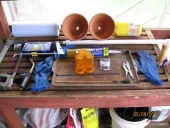
 1
1








Forcing Nature is a force NOT recognized by Nature! http://permaculturehelp.com
 2
2




 1
1




Idle dreamer
 3
3












Intermountain (Cascades and Coast range) oak savannah, 550 - 600 ft elevation. USDA zone 7a. Arid summers, soggy winters




gani et se wrote:Alycat, can you elaborate a little on the junk pit? Is it right beside the plant? Under it? I'm thinking of half rotted wood...
Thanks,
Gani




 1
1




Shaz Jameson wrote:What about re-using plastic bottles for ollas in places where it freezes?
I know plastic is the demon but it's free and it's re-using... or is the problem with leachate?
I'm just thinking I've got really sandy soil and along with a 'junk pit' some ollas could be quite helpful... I will have a scout around for unglazed clay pots, that's an awesome link




Shaz Jameson wrote:What about re-using plastic bottles for ollas in places where it freezes?
I know plastic is the demon but it's free and it's re-using... or is the problem with leachate?
I'm just thinking I've got really sandy soil and along with a 'junk pit' some ollas could be quite helpful... I will have a scout around for unglazed clay pots, that's an awesome link








Shaz Jameson wrote:Good point Charli.
Aly -- using them above ground? I thought it was always in the ground? Did you just got for pinhole size then?









 Will experiment!
Will experiment!



James Slaughter wrote:I would think they'd only be useful in certain vegetable setups, especially for shallower rooted varieties (lettuce, etc).




Moderator, Treatment Free Beekeepers group on Facebook.
https://www.facebook.com/groups/treatmentfreebeekeepers/






|
"To do good, you actually have to do something." -- Yvon Chouinard
2024 Permaculture Adventure Bundle
https://permies.com/w/bundle
|


